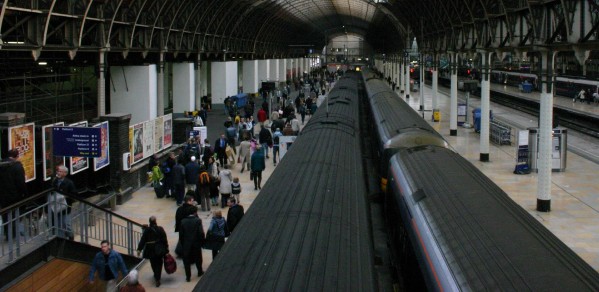
A risk assessment produced by Department of Engineering researchers has found troubling levels of pollution inside London’s Paddington Station.
Regulators should consider setting standards for train station air quality in the same way we regulate outdoor air quality.
Dr Adam Boies
The team found that during one week in September 2012, the air quality was at least as bad as air by a busy roadway nearby. And in many cases it was worse. Dr Adam Boies, Energy Efficient Cities University Lecturer in the Energy Group, along with Dr Jacob Swanson and PhD student Uven Chong of the Energy Efficient Cities Initiative, published their findings in the journal Environmental Research Letters.
“There is an obvious risk associated with exhausting diesel emissions into a semi-enclosed environment, yet it has not received much study,” Dr Boies said. “These results show that regulators should consider setting standards for train station air quality in the same way we regulate outdoor air quality. It is too soon to state what the health impacts for workers or patrons of the station are, but further study could provide those answers.”
Paddington Station is a terminus, with trains only entering from one side and the rest of the building largely enclosed. The station delivers 38 million passengers to their destinations each year, acting as a hub for train services to the west and southwest. Around 70 percent of trains at Paddington are powered by diesel engines; trains manufactured before 2006 are not subject to European regulations on their emissions. Additionally, there are currently no air quality regulations for rail stations in the UK, but the pollution could be harmful to health – particularly for station staff and workers at food outlets, who are inside the station all day.
“If the same standards that apply for outdoor air applied to indoor air, we found that pollution levels within Paddington Station exceeded such levels multiple times throughout the week we analysed,” Boies said. “And it is likely that if a longer study was permitted by station operators, significantly more exceedances would have been recorded.”
The team installed kits at five locations inside the station to measure the mass of particulate matter on two platforms, near food outlets that cook with gas, on the ramp of the main station exit and on the roadside outside. They also monitored nitrogen oxides, sulphur dioxide, and particulate matter size and number at two locations. The measurement campaign ran from 17 to 21 September 2012, with measurements beginning at around 4a.m. and lasting until battery ran out roughly 8 hours later.
Paddington Station’s hourly mean particulate mass concentrations averaged 16 µg/cubic metre whilst the hourly mean NO2 concentrations averaged 73 parts per billion and SO2 concentrations averaged 25 parts per billion. There were five instances when the hourly mean NO2 concentrations exceeded the 106 ppb hourly mean limit set by the European Union for outdoor air quality. These standards allow 18 such hourly exceedances per year. At times the hourly averages exceeded the annual average EU standard for ambient air quality of 25 µg per cubic metre.
The team compared the station results with those from Marylebone Road, a busy street about 1.5 km away. Particulate mass from at least one measurement site within the station was higher than at Marylebone Road on three out of four days, whilst NO2 was higher within Paddington on four-out-of-five days and SO2 was higher within the station on all three days it was measured.
“While the long-term solution for reduced pollution levels is likely electrification, we need not wait until electrification comes to take action,” Boies said. There is currently a £6 billion programme of electrification on the Great Western Main Line that terminates at Paddington, with completion due in 2018. “The majority of diesel trains operating in Paddington Station were built prior to modern regulations and have no exhaust after-treatment whatsoever. We would never allow diesel vehicles into London that had such poor emissions control.”
The studies were part of the Energy Efficient Cities Initiative (EECi), which aims to determine the impacts on UK cities of energy use for transportation and in buildings. “We found that very little was known about the air quality of stations housing diesel trains, thus we set out to conduct the first known study to determine whether air quality concerns existed with such stations” Boies said.
“There are many solutions to air quality problems, so long as we understand the root cause,” Boies continued. “I am hopeful that with further work, air quality in one of the UK’s most important transportation modes can be drastically improved.”

